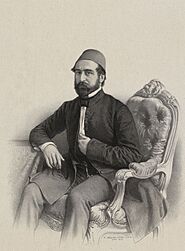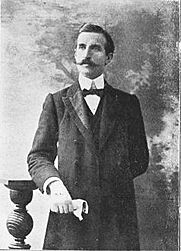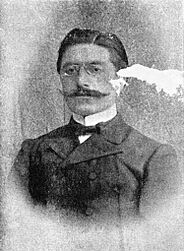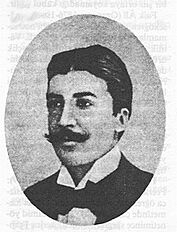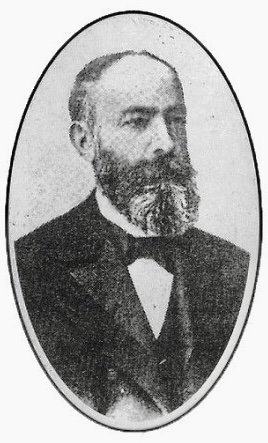Tanzimat facts for kids
The Tanzimat (which means "Reorganization" in Ottoman Turkish) was a special time of change and updates in the Ottoman Empire. It started in 1839 with an important document called the Edict of Gülhane. This period of reforms lasted until 1876, when the First Constitutional Era began.
The main goal of the Tanzimat was not to completely change everything, but to make the Ottoman Empire more modern. Leaders wanted to make the empire stronger and keep its lands safe. They faced challenges from different groups inside the empire who wanted their own countries (nationalism). They also faced strong countries outside the empire. The reforms tried to make all the different people in the empire feel like one group, called Ottomans. This was meant to stop the rise of nationalism.
Some historians say that while the reforms promised equality for non-Muslims, Muslims still had more power in real life. Other experts believe that non-Muslims found it harder to protect their legal rights. This led to their lands being taken and people moving away. Part of the reforms also included new economic rules. Many changes were made to give people more freedom. However, some Muslims felt these changes were too much like foreign ideas. This made it harder for the government to make reforms. During the Tanzimat, the government created a modern army where people had to serve. They also updated the banking system. Religious laws were replaced with new, non-religious laws. Old workshops (guilds) were replaced with modern factories. The Ottoman Post Office started in Istanbul in 1840.
Contents
Why the Reforms Started
The idea for these changes came from sultans like Mahmud II (who ruled from 1808 to 1839) and his son Abdulmejid I (who ruled from 1839 to 1861). Important government officials, many of whom had studied in Europe, also helped. They all realized that the old religious and military systems were not working well for the empire anymore.
Many of the early changes were about how people looked, like new uniforms. This was meant to help government workers think in a more modern way. Many officials were told to wear clothes that looked more like those in Western countries. A lot of the reforms tried to copy successful ideas from Europe. For example, the reforms were greatly influenced by French laws, especially because more Ottoman students were studying in France.
Some of the changes included stopping the old system where Christian boys were taken for the army. Instead, everyone had to serve in the army. There were also updates to education, government, and laws. The government also tried to stop political corruption.
Another important idea was called Ottomanism. This policy aimed to bring together all the different people in the Ottoman lands. This included Muslims and non-Muslims, Turks and Greeks, Armenians and Jews, Kurds and Arabs. This policy officially began with the Edict of Gülhane in 1839. It said that all Ottomans, whether Muslim or not, were equal before the law.
- Examples of dress reform
-
Diplomat Mehmed Cemil Bey wearing a frock coat and a bow tie.
Reasons for the Reforms
This big project was started to fight against the slow weakening of the empire. The Ottoman Empire had been losing land and power compared to European countries. There were reasons for the reforms both inside and outside the empire.
The main reason for the Tanzimat was to make the army better. They wanted to modernize it and learn from European armies. The old Ottoman army, the Janissaries, was not as strong as it used to be. So, rebuilding the army with European ideas was a necessary change. The Ottoman Empire had many different cultures. A second goal of the Tanzimat reforms was to make the social system fairer. Before, Muslim people often had more advantages. Another key part of these reforms was ending the İltizam system. This was an old way of collecting taxes from land.
Inside the empire, leaders hoped that ending the millet system would create a stronger central government. The millet system allowed religious groups to govern themselves. By ending it, the government hoped to have more direct control over all its citizens. They also hoped that being more open to different groups would attract more people to the empire. There was a worry about fighting between Muslims and non-Muslims. Giving more religious freedom to everyone was supposed to reduce this danger. Giving more rights to Christians in the empire was also thought to reduce the chance of other countries getting involved on their behalf.
The Tanzimat reforms were pushed by liberal ministers and thinkers. These included people like Dimitrios Zambakos Pasha and Kabuli Mehmed Pasha. A secret group called the Young Ottomans also played a role. Liberal thinkers like Midhat Pasha helped too. Midhat Pasha is often seen as one of the founders of the Ottoman Parliament. Because of money problems and political issues in 1875–1876, Midhat Pasha helped create the Ottoman constitution of 1876. This constitution marked the end of the Tanzimat period.
Key Reforms

The Tanzimat reforms started under Sultan Mahmud II. On November 3, 1839, Sultan Abdulmejid I issued an imperial order called the Edict of Gülhane. This was followed by many laws that put its ideas into action.
In the edict, the Sultan said he wanted "to bring the benefits of good government to the provinces of the Ottoman Empire through new systems." Some of the main reforms included:
- Guarantees to make sure Ottoman people were safe in their lives, honor, and property (1839).
- The first Ottoman paper money was introduced (1840).
- The first post offices opened in the empire (1840).
- The finance system was reorganized (1840).
- The Civil and Criminal Laws were updated (1840).
- A council for public education was set up (1841). This was the start of the First Ottoman Parliament (1876).
- The army was reorganized. A regular way of recruiting soldiers and fixing how long they served was introduced (1843–44).
- The Ottoman national anthem and Ottoman national flag were redesigned (1844).
- The first empire-wide Ottoman census was done in 1844 (only male citizens were counted).
- The first national identity cards were issued (1844).
- A Council of Public Instruction (1845) and the Ministry of Education (1847) were created.
- The first modern universities (1848), academies (1848), and teacher schools (1848) were established.
- The Ministry of Healthcare was set up (1850).
- New laws for commerce and trade were introduced (1850).
- The Academy of Sciences was established (1851).
- A company was formed to operate the first steam-powered ferries (1851).
- The modern Municipality of Constantinople was set up (1854). A City Planning Council was also created (1855).
- The Hatt-ı Hümayun of 1856 promised full legal equality for citizens of all religions (1856).
- New rules for better public service and trade were made.
- The first telegraph networks (1847–1855) and railway networks (1856) were built.
- Old workshops (guilds) were replaced with factories.
- The Ottoman Bank was established (1856), and later the Ottoman Stock Exchange (1866).
- A new Land Code was introduced (1858).
- Private publishers and printing companies were allowed (1857).
- The School of Civil Service and the School of Economical and Political Sciences were established (1859).
- New rules for the press and journalism were made (1864).
- The Imperial Ottoman Lycée at Galatasaray was established (1868).
- The Nationality Law of 1869 created a common Ottoman citizenship for everyone, no matter their religion (1869).
The Edict of Gülhane of 1839
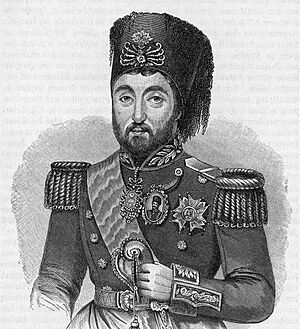
The Edict of Gülhane was the first big reform during the Tanzimat period. It was a key step towards making the government less focused on religion. The decree was named after the rose garden (gülhane) at the Topkapi Palace. It ended the system where people paid taxes by farming. Instead, a new system with paid tax collectors was created. This showed how the Tanzimat reforms aimed to centralize power. The Edict of Gülhane also introduced forced military service based on how many people lived in an area.
However, the most important part of the Gülhane decree was that it made the law apply to everyone. This included non-Muslims. It guaranteed the right to life and property for all. This ended an old system where the ruler could execute servants or take their property whenever he wanted. These reforms aimed to create legal and social equality for all Ottoman citizens. The reforms also ended the millet system in the Ottoman Empire. The millet system created religious communities that ran themselves. People were organized into these groups, and some often had special benefits. This new rule ended those special benefits and aimed for a society where everyone followed the same law.
The new reforms called for almost a complete change in public life in the Ottoman Empire. Under these changes, a system of state schools was set up to train government workers. Ottomans were encouraged to attend these schools. Each province was organized so that every governor had a council to advise them. They also had specific duties to better serve their area. The reforms also called for a modern financial system. This included a central bank, government bonds, and a decimal currency. Finally, the reforms expanded roads, canals, and rail lines for better communication and transportation.
How People Reacted
Not everyone was happy about the edict. Christians in the Balkans did not support the reforms. They wanted to govern themselves, which became harder under a strong central government. In fact, its adoption caused some areas to try and become independent by rebelling. Strong support from Britain was needed to make sure the reforms were put in place.
The Edict of 1856 and Religious Freedom

The Reform Edict of 1856 was meant to keep the promises of the Tanzimat. This Edict was very clear about the rights of non-Muslims. It was seen as a result of religious changes that happened after the 1839 Edict. Officially, one goal of the Tanzimat was to stop forced conversions to Islam. It also made it illegal to execute people who left Islam. However, this tolerance for non-Muslims seemed to be limited until the Reform Edict of 1856. The Ottoman Empire tried many ways to include non-Muslims. At first, it allowed non-Muslims to apply for Dhimmi status. Having Dhimmi status meant non-Muslims could live in the Ottoman Empire and own property. But they had to pay special taxes called jizya.
For the Ottoman leaders, "freedom of religion" meant "freedom to defend their own religion."
Impact of the Reforms
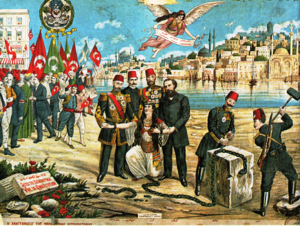
Even though the Edict of Gülhane and the Tanzimat provided strong guidelines, they were not a constitution. They did not take away the Sultan's power.
Still, the Tanzimat reforms had big effects. People who went to the new schools during this time became important leaders later on. These included Mustafa Kemal Pasha, who founded the Republic of Turkey. Many other leaders and thinkers from the Balkans, the Middle East, and North Africa also came from this period.
The system eventually changed because of talks with powerful European countries after the Crimean War. As part of a new agreement in 1856, European powers wanted ethnic groups within the empire to have more self-rule. This was different from the Ottomans' idea of equality, which meant everyone being treated the same under the law. This change helped the Christian middle class grow stronger, increasing their money and political power.
The reforms reached their peak in 1876. This is when an Ottoman constitution was put in place, which limited the Sultan's absolute power. More details about this time are found in the First Constitutional Era. Although the new Sultan Abdul Hamid II signed the first constitution, he quickly went against it.
Some experts believe that from the traditional Muslim point of view, the Tanzimat's big change for non-Muslims (from being a lower status to equal subjects) caused some social tensions. These tensions were a reaction from some parts of the Muslim community to the new laws. This is because the Tanzimat's ideas were put in place from the top down and did not always match what society believed.
Impact in Different Areas
In Lebanon, the Tanzimat reforms aimed to bring back the idea of everyone being equal before the law. However, the government thought that the old social order, where some groups were higher than others, would stay the same. Instead, the changes led to different understandings of what the Tanzimat meant. Leaders in Mount Lebanon understood the Tanzimat very differently. This led to conflicts between religious groups, like the Maronites and Druze, who had gained new freedoms. As a result, European and Ottoman officials tried to win the loyalty of the local people. The French said they would protect the Maronites, the British protected the Druze, and the Ottomans said the Sultan was kind to all his equal subjects, no matter their religion.
In Palestine, land reforms, especially the changes in land ownership through the Ottoman Land Law of 1858, allowed Russian Jews to buy land. This helped them move there. To collect more taxes, the Ottoman government required Arabs in Palestine to register their lands for the first time. However, many local farmers (fellahin) did not trust the government. They feared that registering their land would only lead to higher taxes or forced military service. Because many farmers could not read, local village leaders (mukhtars) often registered village lands under their own names. This meant they could later claim ownership and sell the farmers' lands to new Jewish immigrants. These mukhtars then moved to Syria or Turkey. Also, rich Christian or Muslim families were able to buy large amounts of land, which they either used themselves or sold.
In Armenia, the Armenian National Constitution of 1863 was approved by the Ottoman government. This "Code of Regulations" had 150 articles written by Armenian thinkers. It set out the powers of the Armenian Patriarch under the Ottoman millet system and the new "Armenian National Assembly".
Political Outcomes
Even with good intentions, the Tanzimat reforms did not fully succeed in the long run. The historical reasons for this failure and its results are studied by historians worldwide. As one scholar, Zeynep Çelik, wrote, "from 1838 to 1908 the Ottoman Empire staged its final but doomed struggle for survival."
Images for kids
-
Tobacco factory in Samsun, 1910.
-
Marmara University, 1880s.
-
Turkish delegates to Budapest
See also
- Emancipation
- Albanian revolt of 1847
- Decline and modernization of the Ottoman Empire
- Ottoman military reforms
- Edict of Gülhane or Tanzimât (تنظيمات) Fermânı (3 November 1839)
- Ottoman Reform Edict of 1856 or Islâhat Fermânı / Islâhat Hatt-ı Hümâyûn-u (18 February 1856) - خط همايون
- Young Ottomans
- Court uniform and dress in the Ottoman Empire


